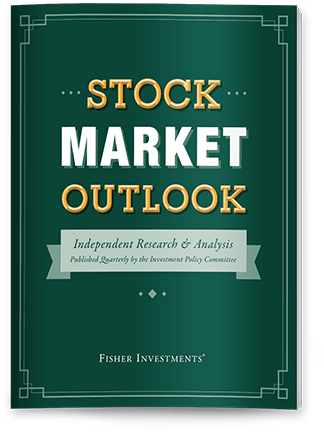Retirement Investing Mistakes
Planning for retirement can be difficult. Concerns about having enough growth or not enough cash or trying to avoid bear markets can and do trip investors up regularly. Ultimately, whether it’s not setting aside a sufficient emergency fund or having an incorrect asset allocation, mistakes can cost you. Additionally, as you near retirement, the impact of these mistakes can feel even bigger as your retirement nest egg becomes your primary source of funds. Often, these retirement planning mistakes begin with an idea that makes perfect sense in isolation, but when evaluated more broadly no longer do. Here are a few mistakes we commonly see:
Not Having a Sufficient Emergency Fund
We believe an emergency fund can be an important part of a successful retirement plan. Whatever your income level, an emergency can quickly darken other parts of your financial picture. While we don’t think keeping the majority of your savings in cash is a great idea, having cash in an emergency fund to pay for critical expenses can help keep your long-term strategy on track.
If you don’t have a large enough emergency fund, you may need to tap other sources that are more costly, whether from retirement accounts like a 401(k), IRA or Roth IRA which have early withdrawal penalties, or from credit cards with high interest rates. Each of those have their own drawbacks but are typically much more expensive than just using cash.

Where Might the Market Go Next?
Confidently tackle the market’s ups and downs with independent research and analysis that tells you where we think stocks are headed—and why.
Investing Too Conservatively
While an emergency fund is important, it shouldn’t represent your whole portfolio. “Conservative” can suggest prudence, wisdom and a desire to avoid volatility. Investing conservatively may seem like the right way to go for some retirees for at least a portion of their portfolios. But if you take a closer look, having a conservative portfolio comes with its own risks.
When you retire, one of the biggest risks you face is outliving your assets, which can happen if your asset allocation limits your portfolio’s potential growth too much. If you’re considering more “conservative” investments like bonds, cash or other assets, keep in mind they typically don’t have the same long-term growth potential as equities. This can be especially problematic if you, like many retirees, have a long investment time horizon and need your retirement savings to grow or at least keep pace with inflation to meet your retirement goals. Having sufficient growth in your portfolio to offset inflation’s impact is crucial for maintaining your purchasing power and retirement income.
This can be especially problematic if you, like many retirees, have a long investment time horizon and need your retirement savings to grow or at least keep pace with inflation to meet your retirement goals. We believe an emergency fund can be an important part of a successful retirement plan.
Withdrawing Too Much Money
The primary point of a retirement portfolio is to fund the years when you aren’t working. While Social Security may help alleviate some of your cash flow needs and supplement your retirement income, for many retirees it isn’t enough on its own. The very biggest risk you face during that time is depleting your assets while you still need them. Large annual withdrawals typically put the greatest strain on your portfolio during retirement.
You can calculate your annual withdrawal rate by using your account’s online-access tools. It usually isn’t too hard to sort the transactions page to view your withdrawals for the year. Total the past year’s withdrawals, and then divide that sum by the value of your portfolio at the beginning of the year. The resulting number is your withdrawal rate for the year.
How high is it? If it is lofty—8%, 9%, 10%—you could very well have a major, acute and immediate problem in need of rectifying. Even if it is a more manageable level—4%, 5%, 6%—you should consider the worst-case scenario and assess how you would live if you had to slash this amount by a quarter or half. It may also be prudent to find other potential sources for funds or income to help supplement your portfolio withdrawals.
Failing to Diversify Your Retirement Plan
Diversification refers to how broadly your portfolio invests across different asset classes and sub asset classes. If you’re investing in stocks, you should consider monitoring three different types of equity diversification in your retirement planning portfolio: Security-specific, sector and country diversification.
Security-specific diversification. Many investors incorrectly believe they need to invest in funds—rather individual stocks—to diversify their assets. However, we believe most high-net-worth investors can properly diversify their portfolios using individual securities as long as you spread their risk across various sub-asset classes—such as sectors, countries or company size.
Many investors understand the importance of not investing too heavily in one company, so they often elect to acquire their equity exposure through funds. Funds come in all shapes and sizes, whether they are actively managed mutual funds, Exchange Traded Funds (ETFs) or index funds. These can be great tools for investors with smaller portfolios to diversify themselves across various companies, but a common mistake we find is that investors tend to over-diversify their portfolios.
The average US mutual fund holds about 295 securities, so owning just 3 similar mutual funds means you could own the entire S&P 500 nearly two times over. Exposure to so many stocks can make even matching the performance of the overall market difficult once fees are taken out. Individual stocks and bonds are often held in multiple funds, so if you hold many funds, this could lead to an un-intended over-concentration in certain securities.
Sector diversification. Stocks in the same or related sectors tend to have positive correlation—they often react similarly to one another. In 2000, technology stocks were bid up to overly-optimistic levels, only to come crashing down. In 2008, bank stocks were decimated. So while you might be diversified across various companies, you still may be over-concentrated in one sector, which may be risky.
How do you know if that is the case? One way is to compare your weight to the broader market by using a benchmark. An appropriate benchmark is necessary to measure relative risk, return and weights towards certain sectors, countries and other parameters. Don’t just find any index that matches what you happen to own. Rather, pick a broad market index and use it as a blueprint for portfolio construction.
Country diversification. Just as certain market sectors sometimes take a bigger hit than others, the same can be said for the markets of individual countries or regions. Diversifying your investments globally can help spread risk across continents, currencies and regions. However, like any other type of investing, country diversification comes with risks.
Foreign political systems and regulations may operate differently from those in the U.S. Other risk factors to consider include currencies and taxes. Foreign exchange rates vary and can experience periods of volatility, which can affect stock market performance. Foreign tax rates can also change as economic and political changes occur in individual countries.
Trying to Time the Market
It is human nature to want to sidestep negative volatility. But volatility, we like to say, is the price you pay for the historically high long-term return of stocks. Timing market corrections—short and typically sudden market downturns of 10 to 20%—can be incredibly difficult, if not impossible. Corrections are based on sentiment and can start without warning. They can also reverse just as quickly. So you could end up selling after stock prices have dropped and buying stocks again after prices have risen. If you try to avoid them you may be more likely to make costly mistakes.
Forecasting bear markets can also be difficult. We define bear markets as fundamentally-driven market downturns of about 20% or more over a sustained period. They are generally caused by weak economic corporate and economic fundamentals and tend to be slower moving than corrections. Trying to avoid a bear market can be done more reliably since there is a fundamental cause, but it’s still incredibly difficult. If you get out of the market without doing your research first, it might cause you to sell too early or buy back in too late, missing the subsequent rebound an crippling your returns.
Further, you may not need to sidestep bear markets or corrections in order to reach your long-term investing goals. Stocks long-term average annualized return of 10% includes all bear markets and corrections.1 Attempting to avoid negative market volatility may cause you to miss capturing positive returns.
1 Source: Global Financial Data, as of 2/13/2023. S&P 500 Total Return Index, 12/31/1925 – 12/31/2021.





